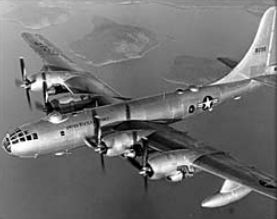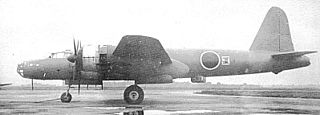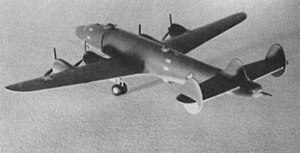
The Boeing B-29 Superfortress is an American four-engined propeller-driven heavy bomber, designed by Boeing and flown primarily by the United States during World War II and the Korean War. Named in allusion to its predecessor, the B-17 Flying Fortress, the Superfortress was designed for high-altitude strategic bombing, but also excelled in low-altitude night incendiary bombing, and in dropping naval mines to blockade Japan. B-29s dropped the atomic bombs on Hiroshima and Nagasaki, the only aircraft ever to drop nuclear weapons in combat.

The Consolidated B-24 Liberator is an American heavy bomber, designed by Consolidated Aircraft of San Diego, California. It was known within the company as the Model 32, and some initial production aircraft were laid down as export models designated as various LB-30s, in the Land Bomber design category.

The Consolidated B-32 Dominator was an American heavy strategic bomber built for United States Army Air Forces during World War II, which had the distinction of being the last Allied aircraft to be engaged in combat during World War II; that engagement also resulted in the last American to die in air combat in World War II. It was developed by Consolidated Aircraft in parallel with the Boeing B-29 Superfortress as a fallback design should the B-29 prove unsuccessful. The B-32 reached units in the Pacific only in mid-May 1945, and subsequently saw only limited combat operations against Japanese targets before the formal end of the war on 2 September 1945. Most of the extant orders of the B-32 were canceled shortly thereafter and only 118 B-32 airframes of all types were built.

The Douglas XB-42 Mixmaster is an experimental American bomber aircraft, designed for a high top speed. The unconventional approach was to mount the two engines within the fuselage driving a pair of contra-rotating propellers mounted at the tail in a pusher configuration, leaving the wing and fuselage clean and free of drag-inducing protrusions.

The Beechcraft XA-38 "Grizzly" was a World War II-era ground attack aircraft, developed by Beechcraft, but never put into production. The Grizzly was to have been fitted with a forward-firing 75 mm cannon to penetrate heavily armored targets.

The Tupolev Tu-85 was a Soviet prototype strategic bomber based on the Tu-4, an unlicensed, reverse engineered copy of the Boeing B-29 Superfortress. It was the ultimate development of the B-29 family, being over 50% heavier than its progenitor and had nearly double the range. Only two prototypes were built before the program was cancelled in favor of the turboprop powered Tupolev Tu-95 bomber which could cover the same range at a far higher speed.
The Tupolev Tu-75 was a military transport variant of the Tu-4 bomber, an unlicensed, reverse engineered copy of the Boeing B-29 Superfortress. The Tu-75 was similar to the Tu-70 airliner, both using a new, purpose-designed fuselage. The first Soviet military machine of this class, it was equipped with a rear fuselage loading ramp. It was not placed into production because the VVS decided it would be cheaper to modify its existing Tu-4s for the transport mission and to use its existing Lisunov Li-2 and Ilyushin Il-12 transports.

The Boeing B-50 Superfortress is an American strategic bomber. A post–World War II revision of the Boeing B-29 Superfortress, it was fitted with more powerful Pratt & Whitney R-4360 radial engines, stronger structure, a taller tail fin, and other improvements. It was the last piston-engined bomber built by Boeing for the United States Air Force, and was refined into Boeing's final such design, the prototype B-54. Although not as well known as its direct predecessor, the B-50 was in USAF service for nearly 20 years.
The Boeing Y1B-20 was designed as an improvement on the Boeing XB-15. It was slightly larger than its predecessor, and was intended to use much more powerful engines. It was presented to the Army in early 1938, and two orders were placed soon after. The order was reversed before construction began.
The Douglas XB-31 was the design submitted by Douglas after the request by the United States Army Air Forces for a very heavy bomber aircraft, the same request that led to the Boeing B-29 Superfortress, Lockheed XB-30, and Consolidated B-32 Dominator.

The Nakajima G8N Renzan was a four-engined long-range bomber designed for use by the Imperial Japanese Navy. The Navy designation was "Type 18 land-based attack aircraft" (十八試陸上攻撃機); the Allied code name was "Rita".

The Martin XB-33 Super Marauder was a proposed World War II American bomber aircraft. It was designed by the Glenn L. Martin Company as the Martin Model 190 and was a high-altitude derivative of the company's B-26 Marauder. Two different designs were developed, first as a twin-engined aircraft and then as a four-engined aircraft. The four-engined version was ordered by the United States Army Air Forces, but the program was cancelled before any aircraft were built.

The Boeing XB-39 Superfortress was a United States prototype bomber aircraft, a single example of the B-29 Superfortress converted to fly with alternative powerplants. It was intended to demonstrate that the B-29 could still be put into service even if the first choice of engine, the air-cooled Wright R-3350 radial engine, ran into development or production difficulties.

The Boeing B-29 Superfortress is a United States Army Air Forces long range, strategic heavy bomber that was produced in many experimental and production models from 1943 to 1946.

The XB-38 Flying Fortress was a single example conversion of a production B-17E Flying Fortress, testing whether the Allison V-1710 V type engine could be substituted for the standard Wright R-1820 radial engine during early World War II.

The Boeing YB-40 Flying Fortress was a modification for operational testing purposes of the B-17 Flying Fortress bomber aircraft, converted to act as a heavily armed gunship to support other bombers during World War II. At the time of its development, long-range fighter aircraft such as the North American P-51 Mustang were just entering quantity production, and thus were not yet available to accompany bombers all the way from England to Germany and back.

The Consolidated XB-41 Liberator was a single Consolidated B-24D Liberator bomber, serial 41-11822, which was modified for the long-range escort role for U.S. Eighth Air Force bombing missions over Europe during World War II.

The Boeing XPBB-1 Sea Ranger was a prototype twin-engined flying boat patrol bomber built for the United States Navy. The order for this aircraft was canceled, to free production capacity to build the Boeing B-29, and only a single prototype was completed.

The Ilyushin Il-22, USAF/DOD designation Type 10, was the first Soviet jet-engined bomber to fly. It used four Lyulka TR-1 turbojets carried on short horizontal pylons ahead and below the wing. The engines did not meet their designed thrust ratings and their fuel consumption was higher than planned. These problems meant that the aircraft could not reach its required performance and it was cancelled on 22 September 1947.
















